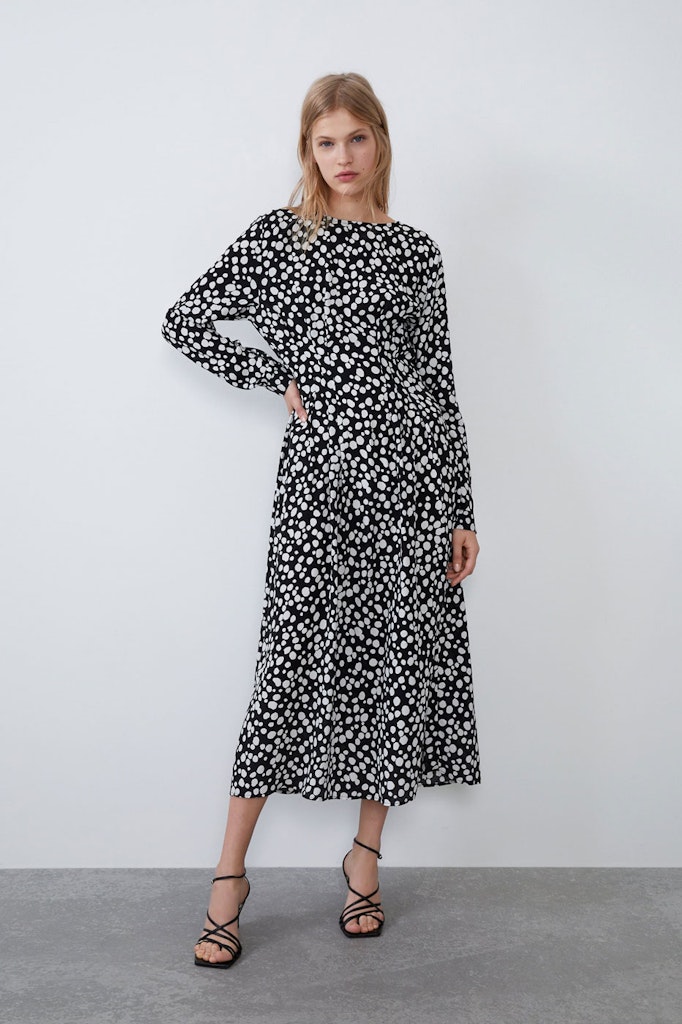February, and — with the exception of those poor pros doing time at the various fashion weeks — even the most diehard style maven will be in hibernation. Now is the time for a detox-cum-palette-cleanse after the tinsel-tittedness of Christmas. We’re all still reeling from vomitous festive excess: too broken of purse and spirit, too overwhelmed with decision fatigue, for the frivolity of fashion.
Save colour, save experimentation, save any form of thought for spring. Let’s treat February as what it is: the stubbed-out fag end of January.
Now, more than any other time, is the moment for a uniform: stripped back, pared down, an opting-out, sans hassle. Personally, I’ve gone back to black, only without the beehive and street drugs. Mostly, I’m rocking jet cashmere roll necks from M&S, teamed with Gap trousers stockpiled while on offer, tucked into Clarks knee boots, rounded off with a military coat.In more girlish moods, the lower half is traded for an ancient wool skirt, or the whole thing for a nun-like black dress.
If I’m looking for heady ostentation, I’ll add a pair of lace stockings (tights, actually, pure YSL while being eight quid from M&S). The point is top-to-toe Stygian simplicity: solid, practical, sleekly cat burglar — and, oh, the exquisite ease of the thing.
Traditionally, the line is that black makes the wearer look thin. This is true to the extent that it makes the wearer look dead, being punishing as it is severe; unless one is as beautiful as Anna Karenina, for whom black is “just a frame, and only was she seen”.
It can make cheap fabrics look expensive, is forgiving of dirt, obviates any anxiety about colour matching, and makes a fabulous backdrop for the more outré accessory. Not that I’m advocating accessories right now, rather a sartorial void.
Black can signify authority. Royalty swathed itself in it for shock and awe purposes: Philip the Good, Charles V, Elizabeth 1.
Black can signify authority. Royalty swathed itself in it for shock and awe purposes: Philip the Good, Charles V, Elizabeth 1. Black clothing was sheep-from-goats expensive, meaning European nobility followed suit, then the merchant class that aped them.
However, black no less spells rebellion. The disaffected youth of the 1590s were the first teen goths, moping about in black to demonstrate their poetic melancholy and Earl of Essex affiliations. Romantic bores Byron, Shelley and Keats adopted a similar course, believing black reflected their counter-cultural angst.
For the Victorians, black meant mourning, or servants and shop girls. Socialites began emulating this guise, drawn by its edgy simplicity, culminating in 1926 when Vogue declared Chanel’s little black dress “The Ford” of the female wardrobe, aesthetic as it was ascetic.
The allure of monochrome silver-screen goddesses was no coincidence. French post-war heroine Juliette Gréco made a fitted black sweater, trousers, flats, fringe and winged kohl a shorthand for artsy, left-bank subculture, as parodied by Audrey Hepburn’s bookish beatnik in the immortal Funny Face (1957).
Fashion’s love of black embraces all these elements: rich and poor, conformist and nonconformist, Coco and Audrey. It can speak of classic French finery in the form of Yves Saint Laurent and Cristóbal Balenciaga, or Japanese chic à la Issey Miyake, Yohji Yamamoto and Comme des Garçons’ Rei Kawakubo. For many of fashion’s elect it’s still a uniform, be it Kawakubo and Yamamoto, the late Karl Lagerfeld, Vogue’s Grace Coddington, Vera Wang, Michael Kors, Jason Wu, Alexander Wang, Tom Ford, Raf Simons, Alber Elbaz, Olivier Rousteing, Riccardo Tisci, Rick Owens and Mary Katrantzou. As perfumers tend to eschew scent, make-up artists slap, so fashion designers crave a blank slate.
The headfuck that is fast fashion plus Instagram has made fashion editors of us all: neurotic, hypersensitive, forever “curating” our own edit. Colour has become our crack — rainbow shades the Insta equivalent of clickbait. One minute it’s all about millennial pink, next it’s Gen-Z yellow, in the frenetic emperor’s new shade-ness of the digital age. Black avoids all this by being not a colour, but light’s absent presence: not merely a symbol of #TimesUp, but a collective time out; resistance to the relentlessness of trends.
Let March bring fillips such as Aurora London’s tulip yellow Gigi bag (£120), and 1001 Stories emerald and fuchsia Pink Panther pumps (£199), both of which I have laid down for spritelier times. For this short month, I’m seeking solace in the sombre.
As Yamamoto replied when asked “Why black?” back in 2000, the first time in a long time when it showed signs of slipping out of modishness: “Black is lazy and easy — but mysterious . . . it takes different aspects in many fabrics. You need black to have a silhouette. Black can swallow light, or make things look sharp. But, above all, black says this: ‘I don’t bother you — don’t bother me!’” Plus an implicit: “And, if you do decide to bother me,
I will destroy you.”
Enjoying The Critic online? It's even better in print
Try five issues of Britain’s most civilised magazine for £10
Subscribe



